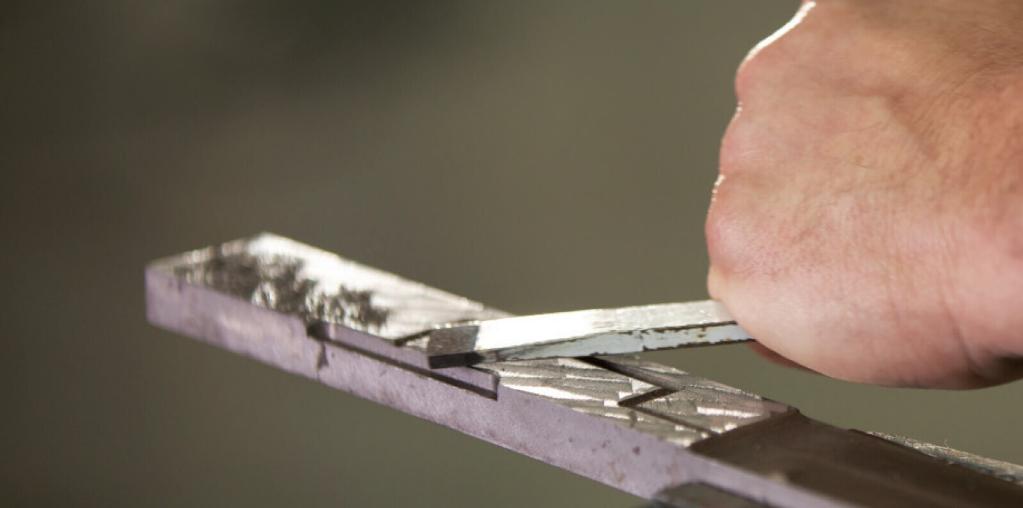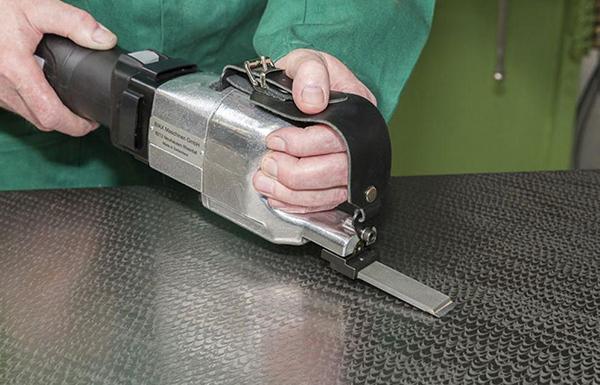Welcome to a world where metal takes on new life - the field of metal scraping! In this comprehensive guide, keen minds will explore various metals, tools, and techniques. The goal is to turn beginners into masters of this craft.

Ferrous Metals often include iron and various forms of steel. Ferrous metals possess magnetic properties. High strength and durability define these metals.
Non-Ferrous Metals exclude iron in their composition. Aluminium, copper, lead, zinc, and tin belong here. Notable for corrosion resistance, non-ferrous metals find utility in a wide range of applications.
Alloy Steels represent another metal type. Different elements combined with iron formulate these steels. High strength, increased hardness, and improved resistance to wear and tear remain hallmark traits.
Stainless Steel, a special type of steel, contains chromium. High resistance to rust and staining are key features here. Commonly used in appliances and cutlery.
Copper Alloys like brass and bronze, hold special place due to their unique properties. Excellent conductivity of heat and electricity, malleability and corrosion resistance make them favorable.
Titanium Alloys offer high strength-to-weight ratio. Exceptional corrosion resistance, and ability to withstand extreme temperatures, tends to make titanium alloys a top choice in aerospace engineering.
Aluminum is a lightweight yet strong metal. Aircraft often benefit from aluminum due to its excellent strength-to-weight ratio.
Brass, an alloy of copper and zinc, finds use in decorations. With high malleability and attractive gold-like appearance, brass adds aesthetic value to many items.
Bronze, another copper alloy, often finds itself in sculptures. Artists favor bronze due to its durability and pleasing color.
Copper, a red-orange metal, is crucial in the manufacturing of electrical wires. High electrical conductivity and flexibility make copper an excellent choice for such applications.
Steel is heavily used in auto parts manufacturing. Durability and cost-effectiveness make steel a preferred choice.
Iron, one of the most abundant elements on Earth, is widely used in construction. High strength and toughness make iron suitable for constructing durable structures.

Metal scraping, or MS, is a process. Metalworkers use special tools to shave thin layers off a metal surface. They do it to smooth out imperfections.
MS is a skill, requiring both experience and precision. To get an even surface, constant checking is vital. This is done with surface plates or master squares.
For many machines, accuracy is key. To achieve this, they need flat, smooth surfaces. MS helps here. It fine-tunes the surfaces, creating an even finish. For example, in machine tools, MS reduces vibration and enhances performance.
The careful removal of metal enhances machinery longevity. So, MS plays a vital role in maintaining efficiency and durability in numerous industries.
Scraping creates a hand-made, bespoke finish. Filing provides an intermediate level of smoothness. Grinding results in the highest smoothness. MS excels in places where high precision is needed.
Grinding removes metal the quickest. Filing takes a little longer. Scraping is the slowest, but the most accurate. For high precision, MS is the go-to method.
Scrapers, burins, and flakers are used in MS. Grinding and filing involves power tools. In MS, manual control brings precision.
Scraping generates minimal waste, compared to filing and grinding. This makes MS an eco-friendly choice.
Scraping needs more skill than filing or grinding. Good hand-eye coordination is necessary. MS operators are highly trained artisans.
Scraping shines in machine tool building and maintenance. It's used in enhancing the precision and life of machine parts. Grinding and filing lack this finesse. Thus, MS holds a special place in the industry.
Known as a versatile tool in metal scraping, a hand scraper delivers precise, controlled cuts. They're used to level metal surfaces, remove old paint, rust, and even adhesives. Stainless steel blades last long, resist corrosion, and offer better results.
A dovetail scraper, with its unique V-shaped blade, excels at cleaning grooves or dovetail joints. This 6-inch long tool can reach confined spaces, making scraping easy, safe, and efficient.
Triangular scraper, with its three sharp points, helps to reach corners and tight spaces. The typical 5-inch length enables an easy grip, with the option of scraping using any of the three edges.
The straightedge tool serves as a guide for scrapers, making sure the surfaces are truly flat. Made from tool steel, these tools come in various lengths, such as 18 or 24 inches.
The surface plate, typically made from granite or cast iron, provides a flat reference plane for scraping. Standard sizes include 24x18 inches or 36x24 inches.
Prussian blue, a bright blue pigment, is applied to surfaces to highlight high spots during scraping. Tubes often contain 20 grams, sufficient for many scraping jobs.
A dial indicator measures surface flatness to ensure accuracy. Reading capabilities are typically 0-1 inch with accuracy of 0.0001 inches.
A file set, with various shapes like flat, round, and half-round, smoothes surfaces post-scraping. The common lengths of 10 and 12 inches provide good control.
Safety glasses protect your eyes during metal scraping. Meeting the ANSI Z87.1 standard, they ensure maximum safety.
Lastly, gloves, especially leather ones, offer hand protection during scraping. Sizes range from small to extra-large to accommodate every hand.

Prepare the work area for metal scraping. Clear the space, ensuring an area of approximately 3x4 meters. Next, sweep the floor to prevent slips or trips. Arrange tools such as scrapers, HSS blades, and safety gear within arm's reach.
Choose the right material for scraping. Opt for metals like cast iron, aluminum, or steel. Hardness must be below 20HRC. Remember, material choice determines the final result. A wrong selection can lead to futile efforts.
Inspect all tools before starting. Check scrapers for sharpness and damage. Replace or sharpen dull scrapers. Inspect HSS blades for any wear. These steps will ensure smooth scraping.
Safety is paramount in metal scraping. Always wear protective gear such as gloves, safety glasses, and steel-toed boots. Keep first aid kit nearby. Follow OSHA guidelines to avoid accidents.
Mark the material before scraping. Use a scribe to mark scraping lines. Use a flat surface as a reference. Always mark in good lighting to ensure accuracy.
Clamp the workpiece securely. A loose workpiece can cause inaccurate scraping. Use a bench vise with a minimum clamping force of 4500N. Secure the workpiece tightly to avoid mishaps.
Conduct an initial assessment of the material. Check for deformities, surface roughness, and hard spots. An RMS surface finish of less than 100 is ideal for scraping.
Select the cutting tool based on the material and task. Flat scrapers are good for large, flat surfaces. Curved scrapers work best for contours. Tool choice impacts the scraping quality.
Clean the surface before scraping. Remove oil, dirt, or rust. Use a wire brush or a cleaning solvent. A clean surface ensures effective scraping.
Make an initial pass with the scraper. Apply force evenly. Aim for a depth cut of about 0.02mm per pass. This prepares the surface for final scraping.
Metal scraping involves a 45-degree scraper angle, a critical factor in producing high-quality surfaces. Scraper positioning is vital, along with the use of flat, round, or triangular scrapers. With careful handling, precise surfaces emerge, promoting reliability and longevity of machinery.
Utilizing a push or pull technique in metal scraping boosts efficiency. A forward push delivers strong, coarse scrapes, while a pulling motion renders finer, smoother scrapes. Remember, the scraping process requires finesse, not brute force.
Proficiency in handling tools like the hand scraper and surface gauge guarantees exceptional work. Smooth hand motion, precise stroke length, and steady grip allow for predictable scrape marks and consistent results.
Establishing a steady rhythm and maintaining a moderate speed ensure precision in metal scraping. Rapid, erratic movements lead to uneven scraping, hampering quality. It’s about technique, not haste.
Expert metal scrapers interpret surface marks, a vital skill in refining flatness and precision. Variations in scrape marks reveal high and low spots on the surface, guiding subsequent scraping efforts.
Adopting effective hatching patterns like the checkerboard or crosshatch guarantees optimal contact and uniform distribution of pressure. A well-executed hatching pattern supports load bearing and reduces friction.
Deburring, the removal of unwanted edges or burrs, ensures a smooth, polished result in metal scraping. Failing to deburr might leave sharp fragments, risking equipment safety and efficiency.
Spotting uses a thin layer of Prussian Blue or engineer's blue to reveal high spots. The process provides a clear map for additional scraping, enhancing surface accuracy.
Repeated passes are common in metal scraping. Each pass further refines the surface. Note that fewer passes may leave machine parts prone to wear and damage.
Metal scraping culminates in fine-tuning surfaces to achieve an accurate, smooth finish. Remember, thorough cleaning of metal dust and particles helps to prevent machinery malfunction.

In metal scraping, measuring surface flatness matters. Instruments like dial indicators help, revealing dips and peaks on the surface. This inspection detects irregularities.
Checking for parallelism comes next. Use a precision straightedge, an essential tool, confirming parts align perfectly, keeping the machine functional.
Check right angles using a square. Precision squares can detect slight discrepancies, making sure every angle is perfect, increasing overall efficiency.
Inspecting the radius of curvature involves specific tools. A radius gauge assists in this process, maintaining smooth, consistent curves.
Straightness in metal components ensures proper operation. By using a precision straightedge, all surfaces stay in line.
Squareness is also vital. Utilize precision squares to confirm angles, guaranteeing parts fit together neatly.
Roundness matters in many parts. Roundness gauges help maintain cylinders and other rounded components, ensuring they meet exacting standards.
Cylinder bore inspection demands precision. Telescopic gauges check the internal diameter, upholding rigorous quality standards.
Inspecting gear teeth is crucial. Use a gear tooth vernier caliper, ensuring each tooth meets specified measurements.
Inspect the surface roughness. A surface roughness tester ensures the scraping process left no unwanted marks, ensuring a perfect finish.
In the metal scraping realm, rust can cause havoc. Applying a coat of oil or WD-40 will aid in blocking moisture. The use of silica gel packs inside storage boxes also helps. Regular inspections, even of stainless steel, keep rust at bay. Be mindful, each step is crucial.
When scraping metal, overheating can be a concern. Keeping the tools cool with regular lubrication is a strategy. The use of heat-resistant materials, like tungsten carbide, can lower the risk. Consistent control of heat is key.
Metal scraping requires careful measures against contamination. Using clean tools, dedicated workspaces, and good hygiene practices are necessary. Frequent cleaning, proper PPE (Personal Protective Equipment), and disposal of scrap are required. Remember, cleanliness in the workspace is fundamental.
Selection of the right material forms the basis of metal scraping. Using high-quality, resilient materials such as steel, brass, or aluminum are crucial. The choice should depend on the task at hand. Hence, material quality plays a pivotal role.
Accurate scraping involves careful measurements. Employing precision tools like micrometers and surface gauges ensures accuracy. Regular calibration of these tools enhances their performance. Understand, every micrometer counts in this job.
Regular maintenance of scraping tools improves their longevity. Regular oiling, proper storage, and sharpness checks are recommended. Dull tools can lead to subpar results. So, consistent tool upkeep is a must.
Diving deep into metal scraping, one uncovers rich details - from tool selection to handling challenges, advanced techniques, and more. Everything points to one truth: skillful scraping transforms metal, honing it to perfection.